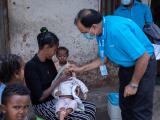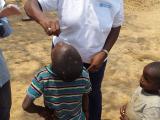Sep 1, 2011
CDC: Immunization rates remain high for children under 3
US vaccination rates for children 19 to 35 months old for most vaccine-preventable diseases increased or remained at high levels in 2010, the Centers for Disease Control and Prevention (CDC) said today. Immunization rates for most of the established childhood vaccines are at or above 90%, according to the report, in Morbidity and Mortality Weekly Report (MMWR), which is based on National Immunization Survey data. The survey found coverage for the measles, mumps, and rubella (MMR) vaccine up from 2009, from 90.0% to 91.5%. Also up were coverage for pneumococcal conjugate vaccine (from 80.4% to 83.3%), the birth dose of hepatitis B vaccine (60.8% to 64.1%), two or more doses of hepatitis A vaccine (46.6% to 49.7%), rotavirus vaccine (43.9% to 59.2%), and the full series of Haemophilus influenzae type b vaccine (54.8% to 66.8%). Coverage for several childhood vaccines surpassed the national health objective of 90%, including MMR, polio, three or more doses of hepatitis B, and varicella. The percentage of children who had not received any vaccinations remained low, below 1%. "Today's report is reassuring," said Anne Schuchat, MD, director of immunization and respiratory diseases at the CDC, in a press release. "As recent outbreaks of measles and whooping cough have shown, vaccine-preventable diseases are still around us."
Sep 2 MMWR report
Sep 1 CDC press release
HHS awards $40 million to strengthen state, local public health
The US Department of Health and Human Services (HHS) yesterday announced the awarding of $40 million in grants to states, tribes, local governments, and schools of public health to strengthen public health agencies and train personnel. Most of the money comes from the Prevention and Public Health Fund created by the Affordable Care Act, HHS said in a press release. Most of the grants are part of the CDC's National Public Health Improvement Initiative (NPHII), a 5-year program now in its second year. The program is designed to help public health agencies track the performance of their programs, foster the adoption of best public health practices, build a nationwide network of performance improvement managers who share strategies, and maximize cohesion and coordination among state and community public health systems, HHS said. The new round of grants also includes funds to support 10 Public Health Training Centers at accredited schools of public health and other public or non-profit institutions, bringing the total number of such centers to 37. The Public Health Training Center Program, administered by the Health Resources and Services Administration, trains public health workers in areas such as environmental health, public health leadership, nutrition, and cultural competency.
Aug 31 HHS announcement
WHO confirms 4 polio cases in China
The World Health Organization (WHO) today confirmed the four cases of polio in Chinese children that were reported Aug 26, stating that they are genetically related to wild polioviruses circulating in Pakistan. The patients, aged 4 months to 2 years, are all from Hetian prefecture in China's Xinjiang Uygur region. Onset dates of paralysis ranged from Jul 3 to Jul 27. In a global alert, the WHO said China's Ministry of Health plans to launch a vaccination campaign this month aimed at 3.8 million children under 15 years old in the outbreak area, as well as children under 5 in other areas of Xinjiang. In addition, "A national team of clinicians, laboratory experts, epidemiologists, and public health experts has been dispatched to the affected region, to assist in the investigation and planning of response activities, and this team will be joined by international support as required," according to the alert. The WHO said the polio cases are the first in China since 1999, when cases were caused by a virus from India. The country's last indigenous infection was in 1994.
Sep 1 WHO global alert
Bosnia-Herzegovina reports 5,000 mumps cases
Bosnia-Herzegovina has confirmed 5,261 cases of mumps from December through July, all in the Federation of Bosnia and Herzegovina, one of the country's three divisions, which translates into 2.3 cases per 1,000 people, according to a Eurosurveillance report today. More than 60% of cases were in males, and 15- to 19-year-olds have been the most affected age-group, accounting for 43% of cases. The next-most-affected age-groups have been 20 to 29 (24%), 30 and older (15%), and 10 to 14 (12%). Monthly case numbers so far have followed a bell-shaped curve, with a peak monthly incidence of 1,240 in April, followed by 970 in May, 848 in June, and 358 in July. The authors conclude, "The outbreak affected mainly those unvaccinated or unaware of their vaccination status and is probably due to vaccination failures during the war and post-war period (1992-1998)."
Sep 1 Eurosurveillance report
Canadian study finds adjuvanted H1N1 vaccine effective
Canadian researchers found the effectiveness of an adjuvanted pandemic 2009 H1N1 vaccine to be 86% when immunization took place 14 or more days before laboratory testing but lower in older and immunocompromised patients, according to a study in Vaccine. For their population-based case-control study, the researchers used data from Cadham Provincial Laboratory (CPL) and the Manitoba Immunization Monitoring System. All Manitoba residents 6 months or older who had a respiratory specimen tested at CPL for 2009 H1N1 were included in the study. Cases were 1,435 patients who tested positive for 2009 H1N1 by polymerase chain reaction, and controls were 2,309 patients who tested negative. While overall effectiveness was 86%, it dropped to 51% in those 50 and older and 67% in immunocompromised people. Effectiveness was 51% in those vaccinated 7 to 13 days before being tested. In a similar Canadian study published in BMJ on Feb 3, researchers found adjusted overall vaccine effectiveness to be 93%
Aug 30 Vaccine abstract
Feb 3 BMJ study




















